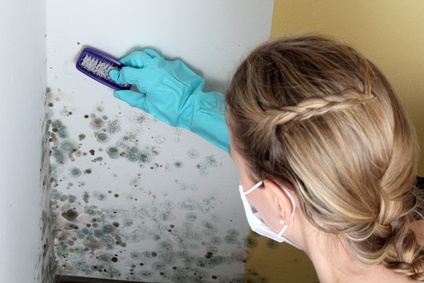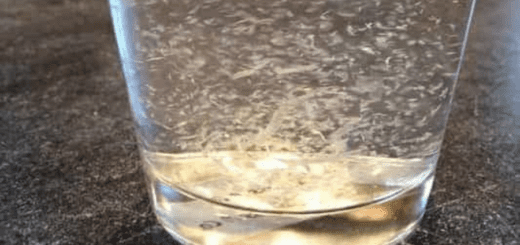How to Detect Mold in Your Bathroom
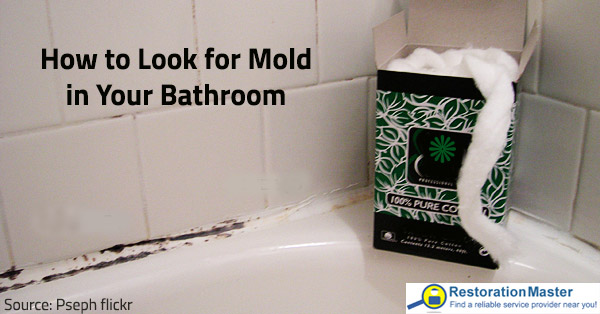
The first signs of moldMold is a type of fungus that grows in damp or humid conditi... More in your bathroom should be a reason enough for you to take immediate measures for its timely removal and future preventionPrevention refers to actions taken to reduce the likelihood ... More.
It is said that if you know your enemies well, you can easily win the battle. And indeed, being aware of the dangers that threaten to ruin your peaceful lifestyle allows you to deal with them in a timely and systematic manner. When you know what the problem is, you do your best to eliminate it and avoid further troubles. When you don’t know of the existence of a problem, however, you can’t take precautionary measures and prevent greater damage.
MoldMold is a type of fungus that grows in damp or humid conditi... More growth in a home is among the problems that are really difficult to detect at an early stage of their development and quite often you may not be sure if a moldMold is a type of fungus that grows in damp or humid conditi... More threat is indeed lurking in some dark and moist areas of your place. In order to successfully prevent, identify, and remove black moldMold is a type of fungus that grows in damp or humid conditi... More, you need to know what causes it and how to check for moldMold is a type of fungus that grows in damp or humid conditi... More.
It is no secret that any small leak, remaining moisture, or condensation can provide the right conditions for moldMold is a type of fungus that grows in damp or humid conditi... More to appear in your home. Of course, this type of high humidityHumidity is the amount of moisture or water vapor present in... More environment is most typical of bathrooms because they are wet most of the time and proper ventilationVentilation is the process of exchanging or circulating air ... More is difficult to ensure in such enclosed, usually windowless spaces. Besides, even the first minor signs of water damage will be relatively easy to spot anywhere in your property but in the bathroom which is meant to be the realm of water. Therefore, bathroom moldMold is a type of fungus that grows in damp or humid conditi... More preventionPrevention refers to actions taken to reduce the likelihood ... More should be one of your primary concerns when it comes to the safety of your home’s indoor environment.
How to Prevent Mold in Bathroom
Apart from leaking pipes and floodingFlooding is the overflow or accumulation of water in areas t... More, lasting dampness and condensation is what causes moldMold is a type of fungus that grows in damp or humid conditi... More in bathrooms. To make the environment unfavorable for moldMold is a type of fungus that grows in damp or humid conditi... More development and to successfully eliminate most of the moisture that results in moldMold is a type of fungus that grows in damp or humid conditi... More growth in your bathroom, follow these simple moldMold is a type of fungus that grows in damp or humid conditi... More preventionPrevention refers to actions taken to reduce the likelihood ... More tips:
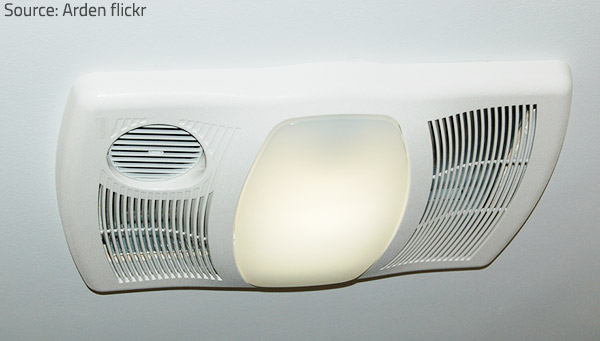
Fresh air will help you keep your bathroom dry and mold-free.
1) Allow free air circulation
- Let your exhaust fans run to provide sufficient circulation of air – they will help reduce the steam and prevent excessive moisture accumulation while you are taking a shower and will speed up the dryingDrying is the process of removing moisture from materials, s... More process after you leave the bathroom;
- Open the bathroom doors and windows (if any) – fresh air helps the bathroom dry completely and has a devastating effect on moldMold is a type of fungus that grows in damp or humid conditi... More sporesSpores are microscopic reproductive units of fungi or mold t... More. Light, especially natural sunlight, is another beneficial factor in your fight against moldMold is a type of fungus that grows in damp or humid conditi... More and mildewMildew is a type of fungus that grows on damp surfaces, typi... More;
2) Remove as much water as possible
- Wipe dry your bathroom floor and walls after taking a shower or use a squeegeeA squeegee is a tool with a flat rubber blade used to remove... More to remove as much of the water as possible;
- Use an air-conditioner, or even a dehumidifierA dehumidifier is a device that removes excess moisture from... More to control the humidityHumidity is the amount of moisture or water vapor present in... More level in your bathroom, especially if you live in a humid climate;
3) Waterproof the walls
- If there are tiles in your bathroom, use a grout sealer to waterproof the grout lines as moldMold is a type of fungus that grows in damp or humid conditi... More develops frequently on them;
- If your bathroom has painted walls, use a semi-gloss paint that is easy to clean and creates such a hard and smooth wall surface that moldMold is a type of fungus that grows in damp or humid conditi... More simply can’t grow on it;
- Have in mind that cracked tiles or missing grout will allow water to leak into the floor or walls, so deal with such seemingly minor issues at the earliest opportunity;
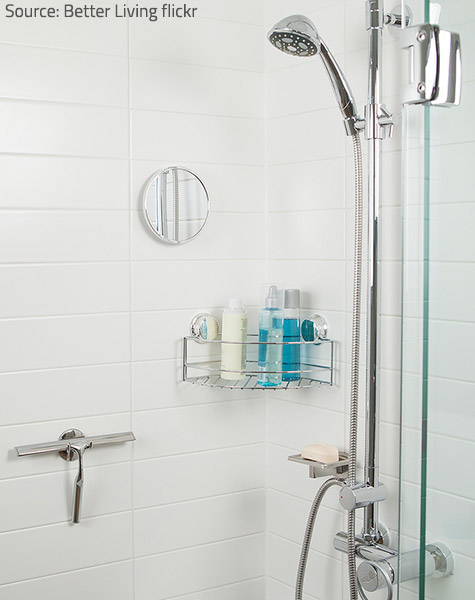
It is a good idea to remove the excessive water from your bathroom walls and floor.
4) Clean regularly
- Use an all-purpose bathroom cleaner on a weekly basis to disinfect all the bathroom surfaces. This includes the bathtub, toilet, and sinks, but also the shower enclosure and cabinets, as well as the doors and walls of your bathroom. Don’t forget to rinse well, to remove any residueResidue is any leftover material, such as soot, dust, or che... More and to wipe the surfaces dry. However, have in mind that abrasive cleaners and scrubbing products can harm the materials making them more susceptible to moldMold is a type of fungus that grows in damp or humid conditi... More growth;
- Wash bathroom rugs every month because moldMold is a type of fungus that grows in damp or humid conditi... More often hides beneath them. Shower curtains should also be regularly washed or wiped using an appropriate detergent. Remember to always stretch them out fully across the length of the shower curtain rod, so that they can dry completely (otherwise moldMold is a type of fungus that grows in damp or humid conditi... More may develop in their folds due to their prolonged dampness);
5) Inspect your plumbing system
- Needless to mention, leaks cause the majority of water damage – so, fix them immediately. Make sure none of the pipes and valves in your bathroom are broken or rusty. Check under the sink and around the base of the toilet – all the seals must be in perfect condition;
- Provide free draining of the water in bathtubs and sinks – if water backs up or drains really slowly, this may cause moldMold is a type of fungus that grows in damp or humid conditi... More growth too, so unclogTo unclog is to clear obstructions from pipes, drains, or eq... More drains with appropriate tools (a plunger or a toilet snake), or commercial liquid products specially designed for the purpose;
- Remember that even if there are no leaks in your bathroom, dripping faucets will provide more than sufficient moisture for moldMold is a type of fungus that grows in damp or humid conditi... More and mildewMildew is a type of fungus that grows on damp surfaces, typi... More to grow. Take measures to avoid such a rookie mistake.
Have in mind that the more cluttered your bathroom is, the greater the chance is for moldMold is a type of fungus that grows in damp or humid conditi... More to develop unseen behind the numerous items. Anything left in your bathroom should be clean and dry, unless you want to discover moldMold is a type of fungus that grows in damp or humid conditi... More patches on its surface.
How to Identify Mold in the Bathroom
When checking for moldMold is a type of fungus that grows in damp or humid conditi... More in the bathroom, you need to know what you are looking for in order to detect it before it’s too late. The first signs of water damage in the bathroom include:

Ants are not supposed to take a shower regularly, are they?
- Musty smell – a persistent damp smell even when the bathroom seems to be completely dry and has been thoroughly cleaned signifies a hidden leak or accumulated moisture which will sooner or later result in moldMold is a type of fungus that grows in damp or humid conditi... More growth and may evolve into a severe problem. MoldMold is a type of fungus that grows in damp or humid conditi... More sporesSpores are microscopic reproductive units of fungi or mold t... More actually decompose materials, giving off an unpleasant stale smell. An earthy smell indicates rotting wood which is a clear sign of present bathroom moldMold is a type of fungus that grows in damp or humid conditi... More. Remember that breathing the moldMold is a type of fungus that grows in damp or humid conditi... More sporesSpores are microscopic reproductive units of fungi or mold t... More can result in health problems and pulmonary diseases, especially if you are allergic or your immune system is weak;
- Muddy appearance – if your tiles seem to be muddy and the entire area feels damp and slimy, this could be black moldMold is a type of fungus that grows in damp or humid conditi... More growing on them;
- Ants – many ants prefer to make their nests in moist wood, so if you notice any in your bathroom, this may be a sign that moldMold is a type of fungus that grows in damp or humid conditi... More is decomposing your floorboards or is rapidly growing beneath the tiles;
- Damaged walls – discoloration, crumbling plasterPlaster is a building material made of lime, gypsum, or ceme... More, blistering paint, cracked or loose tiles and gaps in the grout or the caulk mean that moisture has found its way into the walls and moldMold is a type of fungus that grows in damp or humid conditi... More is silently growing behind the tiles. It’s very bad news if your bathroom walls look warped or if you can detect movement when touching the tiles;
- Suspicious floors – if the floor feels soft, unstable and spongy (the subfloorThe subfloor is the foundational layer beneath flooring mate... More is usually made of plywood which begins to rot when exposed to moisture), the time has come to call professional help to ensure proper water damage restorationWater damage restoration is the professional process of clea... More and bathroom mold removal.
- Visible moldMold is a type of fungus that grows in damp or humid conditi... More – moldMold is a type of fungus that grows in damp or humid conditi... More develops from the inside out, so if you can see it, the problem is probably already severe. Various home moldMold is a type of fungus that grows in damp or humid conditi... More test kits are available to help you identify what kind of moldMold is a type of fungus that grows in damp or humid conditi... More you are dealing with and how dangerous it is.
How to Get Rid of Mold
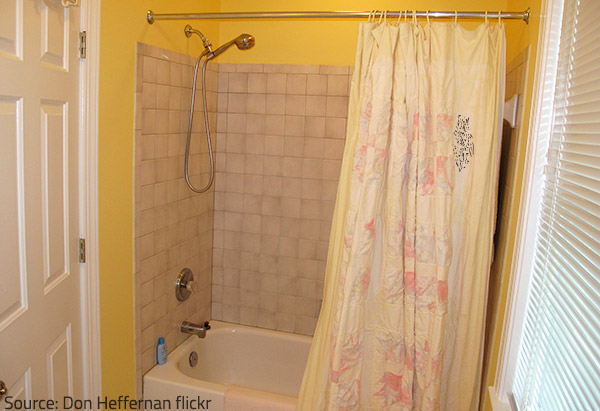
Unless you have taken proper preventive measures, you may get a bad surprise when you draw your shower curtain – moldMold is a type of fungus that grows in damp or humid conditi... More patches develop easily in the folds.
DIY moldMold is a type of fungus that grows in damp or humid conditi... More removal can be successful when the contaminated area is small and the surfaces are easily accessible. Use only quality fungicide sprays (bleach and other household cleaners are usually too weak to eliminate the moldMold is a type of fungus that grows in damp or humid conditi... More sporesSpores are microscopic reproductive units of fungi or mold t... More, while paint and lysol only hide the problem temporarily) and wear personal protection equipment (gloves, goggles, and a respiratory mask). If you have health problems, the affected area is large and difficult to treat, or full mold remediationMold remediation is the process of identifying, removing, an... More is recommended, hire experienced mold removal companies. They will find and eliminate the source of the moldMold is a type of fungus that grows in damp or humid conditi... More, discover and kill all the sporesSpores are microscopic reproductive units of fungi or mold t... More, repairRepair is the act of fixing or restoring damaged property, m... More any damage and clean the contaminated area properly. Mold remediation will be quick and efficient, while future moldMold is a type of fungus that grows in damp or humid conditi... More growth and any mold-induced hazards are prevented.
Mold Symptoms
MoldMold is a type of fungus that grows in damp or humid conditi... More develops rapidly and threatens not only to cause structural damages but to pose health risks, too. The microbesMicrobes are microscopic organisms, including bacteria, fung... More are especially harmful to people who suffer from pulmonary diseases and asthma or have weak immune systems. Some people are very sensitive to fungiFungi are a group of organisms, including mold, mildew, and ... More and when exposed to moldMold is a type of fungus that grows in damp or humid conditi... More for longer periods, they show moldMold is a type of fungus that grows in damp or humid conditi... More allergy symptoms, such as:
- Chronic fatigue and headaches;
- Dizziness, depression and irritability;
- Sneezing and runny or stuffy nose;
- Itchy eyes and swollen eyelids;
- Coughing and respiratory problems.
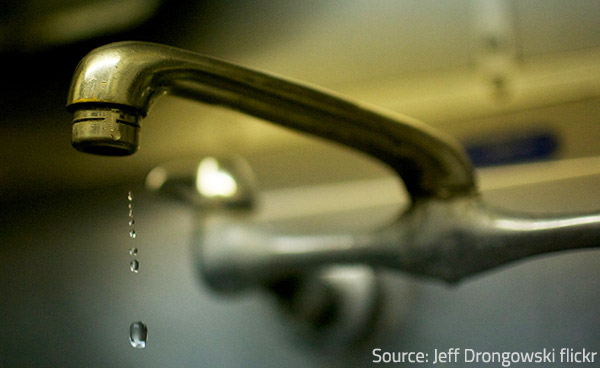
Dripping water will provide enough moisture for moldMold is a type of fungus that grows in damp or humid conditi... More to grow.
It is difficult to be sure if these symptoms are mold-related but if there is no logical or apparent reason for a member of your family to feel sick, look for moldMold is a type of fungus that grows in damp or humid conditi... More in the bathroom – its presence is highly probable and almost certainly the microorganisms will be to blame. Unexpected health problems can appear or existing ones may be aggravated unless you get rid of moldMold is a type of fungus that grows in damp or humid conditi... More as soon as its presence becomes known. The longer it stays in your home, the greater the impact, so look for the first warning signs of moldMold is a type of fungus that grows in damp or humid conditi... More in your home and take immediate action to have it eliminated.











